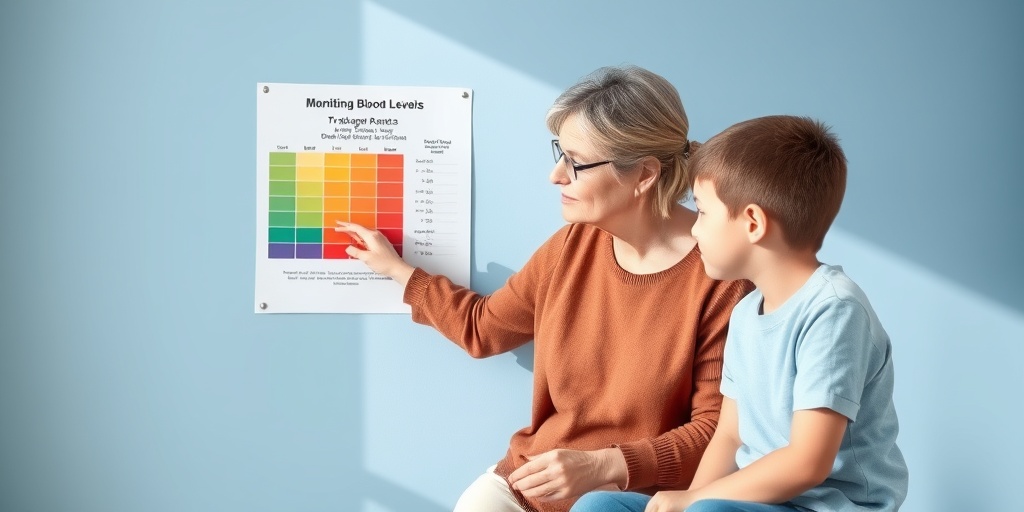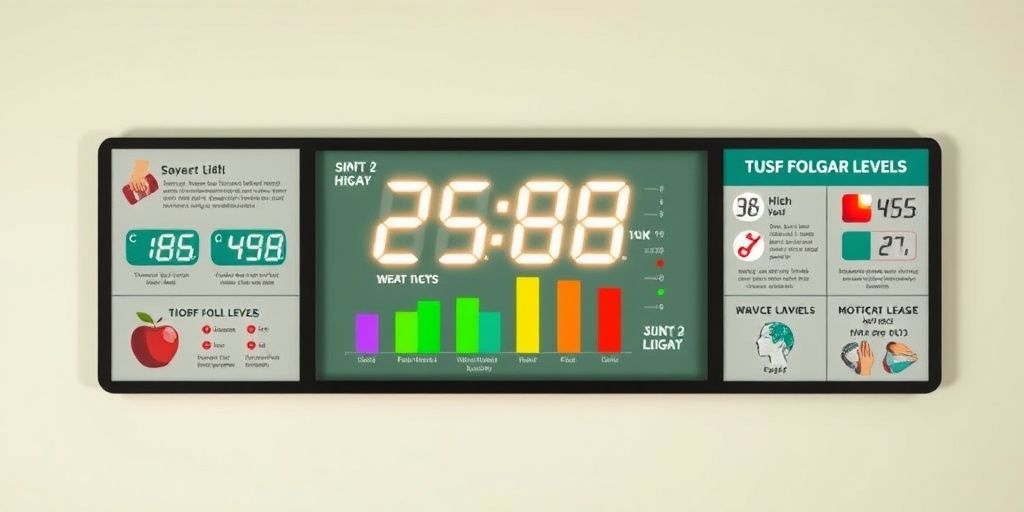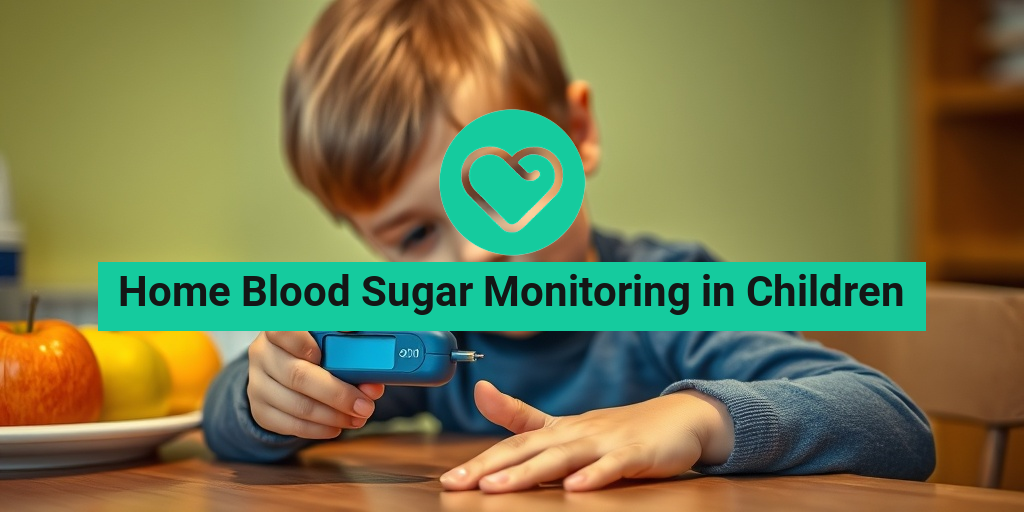What Is Blood Sugar Monitoring?
Blood sugar monitoring is a crucial process that involves regularly checking the levels of glucose in the bloodstream. This practice is especially important for individuals with diabetes, but it can also be beneficial for children who may be at risk of developing blood sugar-related issues. The primary goal of blood sugar monitoring is to ensure that glucose levels remain within a healthy range, which can help prevent complications associated with both high and low blood sugar levels.
How Is Blood Sugar Measured?
Blood sugar levels can be measured using various methods, including:
- Fingerstick Testing: This is the most common method, where a small drop of blood is obtained from a finger prick and tested using a glucose meter.
- Continuous Glucose Monitoring (CGM): This advanced technology involves a small sensor placed under the skin that continuously tracks glucose levels throughout the day and night.
- Laboratory Tests: Blood samples can be taken to measure glucose levels in a clinical setting, providing a more comprehensive view of blood sugar control over time.
Each method has its advantages and can be chosen based on the child’s specific needs and circumstances. Regular monitoring helps parents and caregivers make informed decisions about diet, activity, and medication management.
Importance of Monitoring in Children
Monitoring blood sugar levels in children is vital for several reasons. With the increasing prevalence of type 1 and type 2 diabetes among young populations, understanding the importance of home blood sugar monitoring can empower families to take proactive steps in managing their child’s health.
Preventing Complications
One of the primary reasons for monitoring blood sugar levels is to prevent complications associated with diabetes. High blood sugar (hyperglycemia) can lead to serious health issues, including:
- Diabetic ketoacidosis (DKA)
- Long-term damage to organs such as the heart, kidneys, and eyes
Conversely, low blood sugar (hypoglycemia) can cause symptoms like dizziness, confusion, and even loss of consciousness. Regular monitoring helps parents catch these fluctuations early, allowing for timely intervention.
Empowering Children and Families
Home blood sugar monitoring also plays a significant role in empowering children and their families. By involving children in the process, they can learn about their condition and understand the importance of maintaining healthy blood sugar levels. This education fosters a sense of responsibility and encourages healthy lifestyle choices, such as:
- Making informed dietary decisions
- Engaging in regular physical activity
- Understanding the effects of stress on blood sugar levels
As children grow, this knowledge becomes invaluable, helping them manage their health independently as they transition into adulthood.
Building a Support System
Monitoring blood sugar levels at home also encourages open communication between children, parents, and healthcare providers. Regular discussions about blood sugar readings can help identify patterns and triggers, leading to more effective management strategies. Additionally, resources like Yesil Health AI (yesilhealth.com) can provide evidence-based answers to questions about diabetes management, ensuring families have access to reliable information.
Conclusion
In conclusion, home blood sugar monitoring in children is a vital practice that can significantly impact their health and well-being. By understanding what blood sugar monitoring entails and recognizing its importance, families can take proactive steps to manage diabetes effectively. With the right tools, education, and support, children can lead healthy, active lives while managing their blood sugar levels. 🌟

How to Measure Blood Sugar Levels
Measuring blood sugar levels is a crucial part of managing diabetes, especially in children. Regular monitoring helps parents and caregivers keep track of their child’s health and make informed decisions regarding their diet and medication. Here’s a step-by-step guide on how to measure blood sugar levels effectively.
1. Gather Your Supplies
Before you begin, ensure you have all the necessary supplies:
- Blood glucose meter: This device measures the amount of glucose in your child’s blood.
- Test strips: These are used with the meter to obtain a blood sample.
- Lancing device: This tool helps to prick the skin and obtain a blood sample.
- Alcohol wipes: For cleaning the skin before testing.
- Logbook or app: To record the blood sugar readings.
2. Prepare the Testing Site
Choose a clean and comfortable area for testing. Wash your hands thoroughly and dry them completely. If your child is old enough, encourage them to wash their hands as well. This helps to ensure accurate readings by removing any substances that could affect the test.
3. Insert the Test Strip
Insert a test strip into the blood glucose meter according to the manufacturer’s instructions. Most meters will turn on automatically when a strip is inserted.
4. Prepare the Lancing Device
Load the lancing device with a new lancet. Adjust the depth setting if necessary, depending on your child’s skin type. A shallower depth is often sufficient for children.
5. Prick the Skin
Choose a testing site, typically on the side of the fingertip, as it is less painful. Press the lancing device against the skin and activate it to prick the finger. A small drop of blood should form.
6. Apply Blood to the Test Strip
Touch the drop of blood to the test strip. Ensure that the blood fills the strip’s designated area. The meter will process the sample and display the blood sugar level within seconds.
7. Record the Results
Write down the blood sugar reading in a logbook or app. Keeping a record helps track patterns and informs healthcare providers about your child’s condition.
8. Clean Up
Dispose of the used lancet and test strip properly. Clean the testing area and wash your hands again to maintain hygiene.
Understanding Blood Sugar Levels
Blood sugar levels indicate how much glucose is present in the bloodstream. For children, maintaining these levels within a healthy range is vital for their overall well-being. Here’s what you need to know about blood sugar levels.
Normal Blood Sugar Ranges
Understanding what constitutes a normal blood sugar level is essential for effective monitoring. Generally, the following ranges are considered:
- Fasting (before meals): 70-130 mg/dL
- Postprandial (1-2 hours after eating): Less than 180 mg/dL
These values can vary based on individual circumstances, so it’s important to consult with a healthcare provider for personalized targets.
What Affects Blood Sugar Levels?
Several factors can influence blood sugar levels in children:
- Diet: Foods high in carbohydrates can cause spikes in blood sugar.
- Physical activity: Exercise can lower blood sugar levels, while inactivity may raise them.
- Stress: Emotional or physical stress can lead to increased blood sugar levels.
- Illness: Infections or other illnesses can also affect blood sugar control.
Recognizing High and Low Blood Sugar Levels
It’s crucial to recognize the signs of high and low blood sugar levels:
- High blood sugar (hyperglycemia): Symptoms may include excessive thirst, frequent urination, fatigue, and blurred vision.
- Low blood sugar (hypoglycemia): Symptoms can include shakiness, sweating, confusion, irritability, and dizziness.
Being aware of these symptoms can help parents respond quickly and effectively to their child’s needs.
Importance of Regular Monitoring
Regular blood sugar monitoring is essential for children with diabetes. It helps in:
- Preventing complications: Keeping blood sugar levels within the target range reduces the risk of long-term complications.
- Adjusting treatment: Monitoring allows for timely adjustments in diet, exercise, and medication.
- Empowering children: Teaching children to monitor their own blood sugar fosters independence and responsibility.
By understanding how to measure blood sugar levels and what those levels mean, parents can play a proactive role in managing their child’s health. Regular monitoring and awareness of blood sugar levels can lead to better outcomes and a healthier lifestyle for children with diabetes. 🌟

Common Symptoms of High and Low Blood Sugar
Monitoring blood sugar levels is crucial for children, especially those diagnosed with diabetes or at risk of developing it. Understanding the symptoms of high and low blood sugar can help parents and caregivers respond promptly and effectively. Here’s what to look out for:
Symptoms of High Blood Sugar (Hyperglycemia)
When blood sugar levels rise above normal, children may experience a range of symptoms. Recognizing these signs early can prevent complications:
- Increased Thirst: Children may complain of feeling excessively thirsty, often leading to increased fluid intake.
- Frequent Urination: High blood sugar can cause the body to expel excess glucose through urine, resulting in more frequent bathroom trips.
- Fatigue: A child may feel unusually tired or lethargic, as the body struggles to utilize glucose for energy.
- Blurred Vision: Elevated blood sugar can affect vision, making it appear blurry or distorted.
- Headaches: Persistent headaches can occur due to dehydration or fluctuations in blood sugar levels.
Symptoms of Low Blood Sugar (Hypoglycemia)
Conversely, low blood sugar can also pose serious risks. Here are the common symptoms to watch for:
- Shakiness: A child may exhibit trembling or shaking, which is a common response to low glucose levels.
- Hunger: An intense feeling of hunger can signal that blood sugar levels are dropping.
- Dizziness or Lightheadedness: Low blood sugar can lead to feelings of dizziness, making it difficult for a child to concentrate.
- Irritability: Mood swings or irritability can occur as the brain lacks the necessary glucose for optimal function.
- Confusion: In severe cases, a child may appear confused or disoriented, which requires immediate attention.
Being aware of these symptoms is essential for effective home blood sugar monitoring in children. Parents should educate their children about these signs and encourage them to communicate how they feel, especially if they have diabetes or are at risk.
Factors Affecting Blood Sugar in Kids
Understanding the various factors that influence blood sugar levels in children is vital for effective management and monitoring. Here are some key elements to consider:
Dietary Choices
The foods children consume play a significant role in their blood sugar levels. Here are some dietary factors to keep in mind:
- Carbohydrate Intake: Foods high in carbohydrates can cause blood sugar levels to spike. It’s essential to monitor the type and amount of carbs consumed.
- Meal Timing: Regular meal times help maintain stable blood sugar levels. Skipping meals can lead to fluctuations.
- Snacking: Healthy snacks can help prevent low blood sugar, especially during active play or sports.
Physical Activity
Exercise is another critical factor that affects blood sugar levels:
- Increased Activity: Physical activity can lower blood sugar levels, so it’s important to monitor levels before and after exercise.
- Type of Activity: Different activities can have varying effects on blood sugar. For example, aerobic exercises may lower blood sugar, while strength training can have a different impact.
Emotional Well-being
Stress and emotional health can also influence blood sugar levels:
- Stress Responses: Stress can lead to increased blood sugar levels due to the release of stress hormones.
- Emotional Eating: Children may turn to food for comfort during stressful times, which can affect their blood sugar levels.
Illness and Hormonal Changes
Illness and hormonal changes can also impact blood sugar levels:
- Infections: Illness can cause blood sugar levels to rise, requiring careful monitoring and management.
- Puberty: Hormonal changes during puberty can lead to fluctuations in blood sugar levels, making monitoring even more critical.
By understanding these factors, parents can better manage their child’s home blood sugar monitoring and ensure they maintain healthy levels. Regular communication with healthcare providers is also essential for tailored advice and support. 🩺

Tips for Effective Home Blood Sugar Monitoring in Children
Monitoring blood sugar levels at home is crucial for children with diabetes. It helps in managing their condition effectively and ensures they lead a healthy life. Here are some tips to make home blood sugar monitoring easier and more effective:
1. Choose the Right Equipment
Invest in a reliable blood glucose meter that is easy to use. Look for features such as:
- Memory storage: Can store previous readings for tracking trends.
- Portability: Compact and easy to carry for on-the-go monitoring.
- Ease of use: Simple buttons and clear display for children to operate.
2. Establish a Routine
Consistency is key when it comes to monitoring blood sugar levels. Establish a routine that includes:
- Regular testing times: Test at the same times each day, such as before meals and bedtime.
- Involving your child: Encourage your child to participate in the process to foster independence.
3. Educate Your Child
Teaching your child about their condition and the importance of monitoring their blood sugar can empower them. Use age-appropriate language and resources to explain:
- What blood sugar levels mean: Help them understand the impact of high and low levels.
- How to recognize symptoms: Teach them to identify signs of hypo- or hyperglycemia.
4. Keep a Log
Maintaining a blood sugar log can help track patterns and make it easier to discuss with healthcare providers. Include:
- Date and time: Record when each test is done.
- Blood sugar readings: Note the results for reference.
- Food intake and activity: Document meals and physical activity to correlate with blood sugar levels.
5. Make It Fun
To keep your child engaged, turn monitoring into a fun activity. Consider:
- Color coding: Use stickers or colored pens to mark different readings.
- Rewards: Set up a reward system for consistent monitoring.
When to Seek Medical Advice
While home blood sugar monitoring is essential, there are times when you should consult a healthcare professional. Here are some situations to watch for:
1. Unexplained High or Low Readings
If your child consistently has high blood sugar levels (above 240 mg/dL) or low levels (below 70 mg/dL), it’s important to seek medical advice. These fluctuations can indicate a need for adjustments in their management plan.
2. Symptoms of Diabetic Ketoacidosis (DKA)
DKA is a serious condition that can occur in children with diabetes. Look for symptoms such as:
- Frequent urination
- Extreme thirst
- Nausea or vomiting
- Abdominal pain
- Fruity-smelling breath
If you notice these symptoms, seek medical attention immediately. 🚑
3. Changes in Behavior or Mood
Sudden changes in your child’s behavior or mood can be a sign of fluctuating blood sugar levels. If your child becomes unusually irritable, lethargic, or confused, it’s essential to check their blood sugar and consult a healthcare provider if necessary.
4. Difficulty Managing Blood Sugar Levels
If you find it challenging to maintain your child’s blood sugar levels within the target range, it may be time to consult with a healthcare professional. They can provide guidance on:
- Dietary adjustments
- Insulin management
- Exercise recommendations
5. Regular Check-Ups
Even if everything seems fine, regular check-ups with your child’s healthcare provider are crucial. These visits can help monitor their overall health and make necessary adjustments to their diabetes management plan.
By following these tips for effective home blood sugar monitoring and knowing when to seek medical advice, you can help your child manage their diabetes more effectively and lead a healthier life. 🌟

Frequently Asked Questions about Home Blood Sugar Monitoring in Children
What is Home Blood Sugar Monitoring in Children?
Home Blood Sugar Monitoring in Children refers to the practice of regularly checking a child’s blood glucose levels at home. This is crucial for managing conditions like diabetes and ensuring that children maintain healthy blood sugar levels.
Why is Home Blood Sugar Monitoring important for children?
Monitoring blood sugar levels at home helps parents and caregivers:
- Detect high or low blood sugar levels early
- Adjust insulin doses or dietary plans as needed
- Prevent complications associated with diabetes
- Empower children to understand their health better
How often should I monitor my child’s blood sugar levels?
The frequency of monitoring can vary based on your child’s specific needs and the type of diabetes they have. Generally, it is recommended to check blood sugar levels:
- Before meals
- Before bedtime
- During physical activity
- Whenever symptoms of high or low blood sugar occur
What tools are needed for home blood sugar monitoring?
To effectively monitor blood sugar levels at home, you will need:
- A blood glucose meter
- Test strips
- A lancing device and lancets
- A logbook or app to track results
How can I help my child feel comfortable with blood sugar monitoring?
To make the process easier for your child, consider the following tips:
- Explain the importance of monitoring in simple terms
- Involve them in the process to foster independence
- Use a reward system for successful monitoring
- Make it a routine to reduce anxiety
What should I do if my child’s blood sugar levels are too high or too low?
If your child’s blood sugar levels are outside the normal range, follow these steps:
- For high blood sugar: Administer insulin as prescribed and encourage hydration.
- For low blood sugar: Provide a quick source of sugar, such as juice or glucose tablets, and recheck levels after 15 minutes.
Can children learn to monitor their own blood sugar levels?
Yes! With proper guidance and support, many children can learn to monitor their own blood sugar levels as they grow older. This promotes independence and responsibility regarding their health.
Where can I find more resources on Home Blood Sugar Monitoring in Children?
For additional information, consider visiting:
- Diabetes organizations’ websites
- Healthcare provider resources
- Support groups for parents of children with diabetes
Is there a specific age when children can start monitoring their blood sugar?
Children can start learning to monitor their blood sugar levels as early as age 5, but the ability to do so independently varies. It’s essential to assess their maturity and understanding before allowing them to take full responsibility.
What are the signs of high or low blood sugar in children?
Common signs include:
- High blood sugar: Increased thirst, frequent urination, fatigue, and blurred vision.
- Low blood sugar: Sweating, shakiness, irritability, confusion, and dizziness.
By understanding Home Blood Sugar Monitoring in Children, parents can play a vital role in managing their child’s health effectively. If you have further questions, consult with your healthcare provider for personalized advice.




